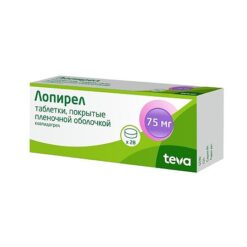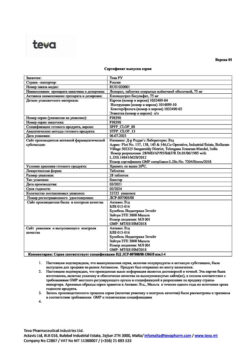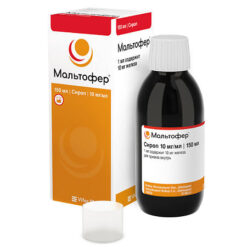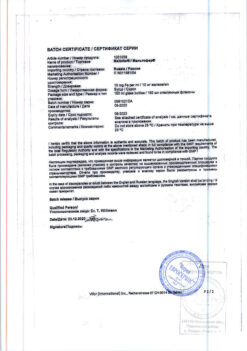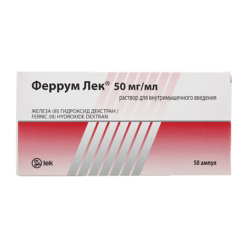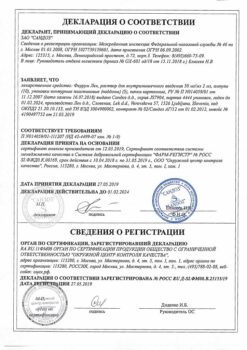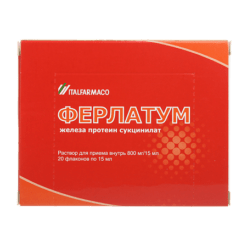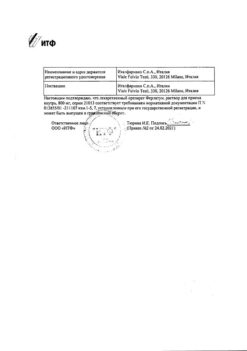No products in the cart.
Lopirel, 75 mg 14 pcs.
€1.00
Out of stock
(E-mail when Stock is available)
Description
Lopirel is an antiplatelet agent; a specific and active inhibitor of platelet aggregation; has coronarodilator effect. Selectively reduces the binding of ADP. to receptors on platelets and activation of GPI Ib/IIIa receptors under the action of ADP, thereby weakening platelet aggregation. Reduces platelet aggregation caused by other agonists by preventing their activation by released ADP, does not affect FDE activity.
It binds irreversibly to platelet ADP receptors, which remain immune to ADP stimulation throughout the life cycle (about 7 days). Inhibition of platelet aggregation is observed 2 h after administration (40% inhibition) of the initial dose of 400 mg. The maximum effect (60% suppression of aggregation) develops after 4-7 days of continuous dosing at a dose of 50-100 mg/day. The antiaggregant effect persists for the entire period of platelet life (7-10 days). In the presence of atherosclerotic vascular lesions it prevents the development of atherothrombosis regardless of the localization of the vascular process (cerebrovascular, cardiovascular or peripheral lesions).
Pharmacokinetics
Absorption – high; bioavailability – high; plasma concentration is low and does not reach the limit of measurement (0.025 µg/L) 2 h after administration. The binding to plasma proteins is 94-98%.
Metabolized in the liver. The main metabolite is an inactive carboxylic acid derivative, the TcT of which is reached after repeated oral doses of 75 mg in 1 hour (TcT is about 3 mg/L). It is excreted by the kidneys 50%, through the intestine – 46% (within 120 hours after administration).
The T1/2 of the main metabolite after single and repeated administration is 8 hours. Concentrations of metabolites excreted by the kidneys are 50%. Concentration of basic metabolite in plasma after 75 mg/day administration is lower in patients with severe kidney disease (CKR 5-15 ml/min) compared to patients with moderate kidney disease (CKR 30-60 ml/min) and healthy persons.
Indications
Indications
Prevention of atherothrombotic complications in patients who have suffered a myocardial infarction, ischemic stroke, or diagnosed with occlusive peripheral artery disease.
Prevention of atherothrombotic events (in combination with acetylsalicylic acid) in patients with acute coronary syndrome:
without ST segment elevation (unstable angina or non-Q wave myocardial infarction), including patients who underwent stenting for percutaneous coronary intervention;
with ST segment elevation (acute myocardial infarction) with drug treatment and the possibility of thrombolysis.
Pharmacological effect
Pharmacological effect
Lopirel is an antiplatelet agent; specific and active inhibitor of platelet aggregation; has a coronary dilation effect. Selectively reduces ADP binding. with receptors on platelets and activation of GPI Ib/IIIa receptors under the influence of ADP, thereby weakening platelet aggregation. Reduces platelet aggregation caused by other agonists, preventing their activation by released ADP, does not affect PDE activity.
Irreversibly binds to platelet ADP receptors, which remain resistant to ADP stimulation throughout the life cycle (about 7 days). Inhibition of platelet aggregation is observed 2 hours after administration (40% inhibition) of the initial dose of 400 mg. The maximum effect (60% suppression of aggregation) develops after 4-7 days of continuous use at a dose of 50-100 mg/day. The antiplatelet effect persists throughout the life of platelets (7-10 days). In the presence of atherosclerotic lesions of the vessel, it prevents the development of atherothrombosis, regardless of the localization of the vascular process (cerebrovascular, cardiovascular or peripheral lesions).
Pharmacokinetics
Absorption – high; bioavailability – high; the plasma concentration is low and 2 hours after administration does not reach the measurement limit (0.025 μg/l). Communication with plasma proteins – 94-98%.
Metabolized in the liver. The main metabolite is an inactive derivative of carboxylic acid, the Tmax of which, after repeated oral doses of 75 mg, is achieved after 1 hour (Tmax – about 3 mg/l). 50% is excreted by the kidneys, 46% through the intestines (within 120 hours after administration).
T1/2 of the main metabolite after a single and repeated dose is 8 hours. The concentration of metabolites excreted by the kidneys is 50%. The concentration of the main metabolite in plasma after taking 75 mg/day is lower in patients with severe kidney disease (creatinine clearance 5-15 ml/min) compared to patients with moderate kidney disease (creatinine clearance 30 to 60 ml/min) and healthy individuals.
Active ingredient
Active ingredient
Clopidogrel
Composition
Composition
Active ingredient:
clopidogrel hydrogen sulfate 97.87 mg, corresponding to 75 mg clopidogrel base;
Excipients:
lactose,
microcrystalline cellulose,
crospovidone (type A),
glyceryl dibehenate,
talc,
Opadry II 85 G34669 pink (polyvinyl alcohol, talc, titanium dioxide (E171), macrogol 3350, lecithin (E322), red iron oxide dye (E172))
Pregnancy
Pregnancy
Lopirel is contraindicated during pregnancy and breastfeeding.
Contraindications
Contraindications
Hypersensitivity, hemorrhagic syndrome, acute bleeding, intracranial hemorrhage and diseases predisposing to their development (peptic ulcer of the stomach and duodenum in the acute stage, nonspecific ulcerative colitis, tuberculosis, lung tumors, hyperfibrinolysis), severe liver failure; for dosage forms containing lactose (additionally): hereditary galactose intolerance, lactase deficiency and glucose-galactose malabsorption syndrome.
Side Effects
Side Effects
From the nervous system and sensory organs: fatigue, asthenia, headache, dizziness, paresthesia, leg cramps, hyperesthesia, neuralgia, cataracts, conjunctivitis.
From the cardiovascular system and blood (hematopoiesis, hemostasis): peripheral edema, arterial hypertension, heart failure, generalized edema, syncope, palpitations, thrombocytopenia, anemia (aplastic or hypochromic), agranulocytosis, leukopenia, neutropenia.
Coagulation disorders and bleeding: purpura, extravasation, epistaxis, gastrointestinal bleeding, joint hemorrhage, bleeding from the urinary tract, hemoptysis, intracranial hemorrhage, retroperitoneal hemorrhage, bleeding from a surgical wound, intraocular hemorrhage, hemothorax, pulmonary hemorrhage, allergic purpura, thrombocytopenic thrombohemolytic purpura.
From the gastrointestinal tract: abdominal pain, dyspepsia, diarrhea, nausea, vomiting, constipation, taste disturbance, perforation of a gastric ulcer, hemorrhagic gastritis, bleeding from an ulcer of the upper gastrointestinal tract, increased activity of liver enzymes, hyperbilirubinemia, hepatitis, hepatic steatosis.
From the musculoskeletal system: arthralgia, back pain, arthritis, arthrosis.
From the respiratory system: inflammation of the upper respiratory tract, shortness of breath, rhinitis, bronchitis, cough, pneumonia, sinusitis.
From the genitourinary system: urinary tract infections, cystitis, menorrhagia.
From the skin: rash, itching, eczema, skin ulcerations, bullous dermatitis, erythematous rash, maculopapular rash, urticaria.
Other: chest pain, injury, flu-like symptoms, pain. Isolated cases of hemolytic uremic syndrome, membranous nephropathy and hypersensitivity reactions (angioedema, bronchospasm, anaphylactic reactions) have been reported.
Interaction
Interaction
Warfarin. The combined use of clopidogrel with warfarin is not recommended, since this combination may increase the intensity of bleeding.
Glycoprotein IIb/IIIa inhibitors. Prescribing glycoprotein IIb/IIIa inhibitors with clopidogrel requires caution.
Acetylsalicylic acid. Acetylsalicylic acid does not change the inhibitory effect of clopidogrel on ADP-induced platelet aggregation, however, clopidogrel potentiates the effect of acetylsalicylic acid on collagen-induced platelet aggregation. However, the simultaneous use of acetylsalicylic acid at a dose of 500 mg 2 times a day did not cause any significant increase in bleeding time, prolonged due to clopidogrel. The safety of long-term simultaneous use of acetylsalicylic acid and clopidogrel has not been established, however, clopidogrel and acetylsalicylic acid can be used simultaneously for up to one year.
Heparin. According to a clinical trial conducted on healthy volunteers, the simultaneous use of clopidogrel and heparin does not require dose adjustment of the latter and does not affect the antiplatelet effect of clopidogrel, however, the safety of such a combination has not yet been established and the simultaneous use of these drugs requires caution.
Thrombolytic agents. The safety of simultaneous use of clopidogrel with thrombolytics has not currently been established, so the simultaneous use of these drugs requires caution.
Nonsteroidal anti-inflammatory drugs (NSAIDs). In a clinical trial conducted in healthy volunteers, coadministration of clopidogrel and naproxen increased the incidence of occult gastrointestinal bleeding. However, due to the lack of drug interaction studies with other NSAIDs, it has not yet been established whether there is an increased risk of gastrointestinal bleeding when using other drugs in this group. Thus, the combined use of NSAIDs and clopidogrel requires caution.
Other drug combinations. No clinically significant pharmacodynamic interaction was detected when clopidogrel was used in combination with atenolol and/or nifedipine. The pharmacodynamic activity of LOPIREL remains virtually unchanged when used simultaneously with phenobarbital, cimetidine or estrogens. The pharmacokinetic properties of digoxin or theophylline do not change when used together with clopidogrel. Antacids do not alter the absorption of clopidogrel.
Data obtained from studies with human liver microsomes indicate that clopidogrel may inhibit the activity of one of the cytochrome P450 enzymes (CYP 2C9). As a result, plasma levels of some drugs, such as phenytoin and tolbutamide, may be elevated because they are metabolized by CYP2C9. The results of the CAPRIE study indicate the safety of the use of phenytoin and tolbutamide in combination with clopidogrel.
Storage conditions
Storage conditions
At a temperature not exceeding 30 °C
Shelf life
Shelf life
2.5 years
Manufacturer
Manufacturer
Actavis Ltd, Malta
Additional information
| Shelf life | 2.5 years |
|---|---|
| Conditions of storage | At a temperature not exceeding 30 °C |
| Manufacturer | Actavis Ltd, Malta |
| Medication form | pills |
| Brand | Actavis Ltd |
Other forms…
Related products
Buy Lopirel, 75 mg 14 pcs. with delivery to USA, UK, Europe and over 120 other countries.


